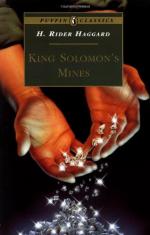As for Khiva himself, we buried what remained of him in an ant-bear hole, together with an assegai to protect himself with on his journey to a better world. On the third day we marched again, hoping that we might live to return to dig up our buried ivory, and in due course, after a long and wearisome tramp, and many adventures which I have not space to detail, we reached Sitanda’s Kraal, near the Lukanga River, the real starting-point of our expedition. Very well do I recollect our arrival at that place. To the right was a scattered native settlement with a few stone cattle kraals and some cultivated lands down by the water, where these savages grew their scanty supply of grain, and beyond it stretched great tracts of waving “veld” covered with tall grass, over which herds of the smaller game were wandering. To the left lay the vast desert. This spot appears to be the outpost of the fertile country, and it would be difficult to say to what natural causes such an abrupt change in the character of the soil is due. But so it is.
Just below our encampment flowed a little stream, on the farther side of which is a stony slope, the same down which, twenty years before, I had seen poor Silvestre creeping back after his attempt to reach Solomon’s Mines, and beyond that slope begins the waterless desert, covered with a species of karoo shrub.
It was evening when we pitched our camp, and the great ball of the sun was sinking into the desert, sending glorious rays of many-coloured light flying all over its vast expanse. Leaving Good to superintend the arrangement of our little camp, I took Sir Henry with me, and walking to the top of the slope opposite, we gazed across the desert. The air was very clear, and far, far away I could distinguish the faint blue outlines, here and there capped with white, of the Suliman Berg.
“There,” I said, “there is the wall round Solomon’s Mines, but God knows if we shall ever climb it.”
“My brother should be there, and if he is, I shall reach him somehow,” said Sir Henry, in that tone of quiet confidence which marked the man.
“I hope so,” I answered, and turned to go back to the camp, when I saw that we were not alone. Behind us, also gazing earnestly towards the far-off mountains, stood the great Kafir Umbopa.
The Zulu spoke when he saw that I had observed him, addressing Sir Henry, to whom he had attached himself.
“Is it to that land that thou wouldst journey, Incubu?” (a native word meaning, I believe, an elephant, and the name given to Sir Henry by the Kafirs), he said, pointing towards the mountain with his broad assegai.
I asked him sharply what he meant by addressing his master in that familiar way. It is very well for natives to have a name for one among themselves, but it is not decent that they should call a white man by their heathenish appellations to his face. The Zulu laughed a quiet little laugh which angered me.




